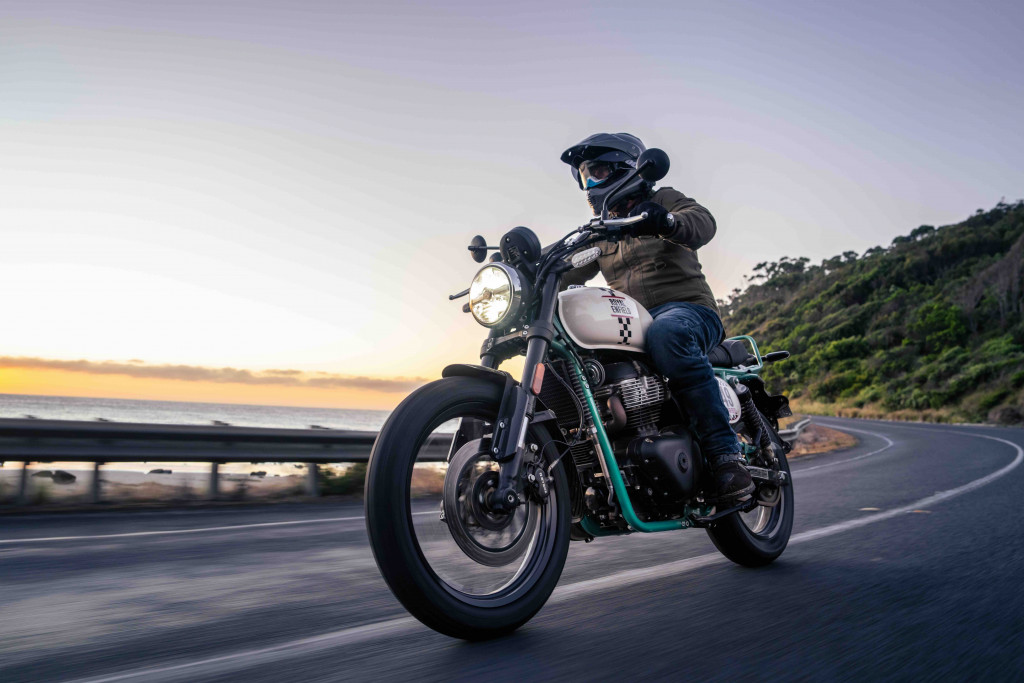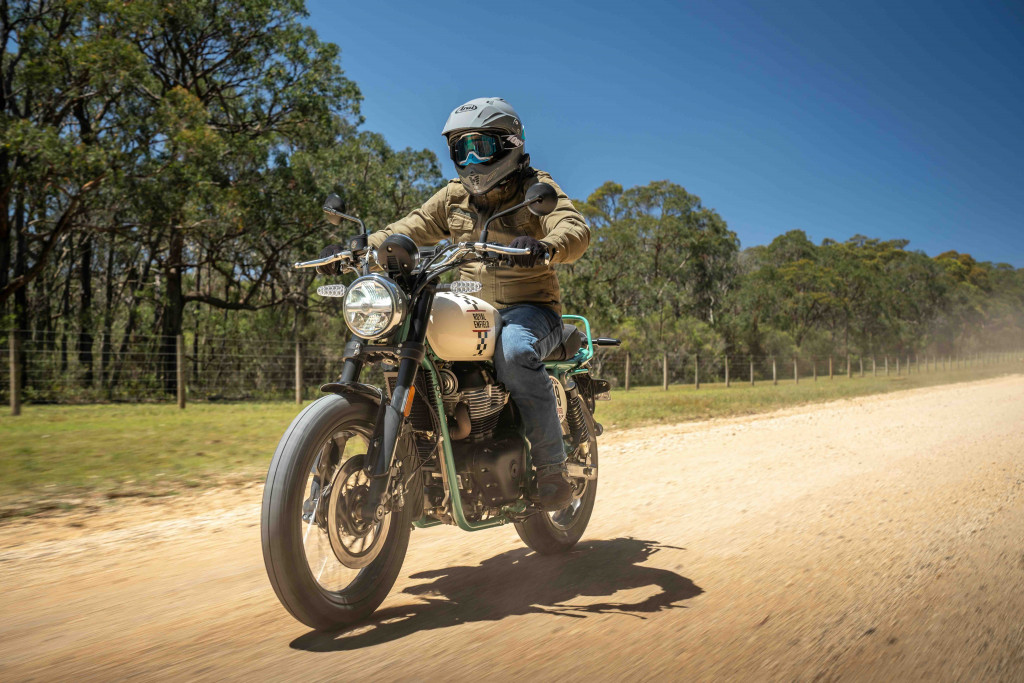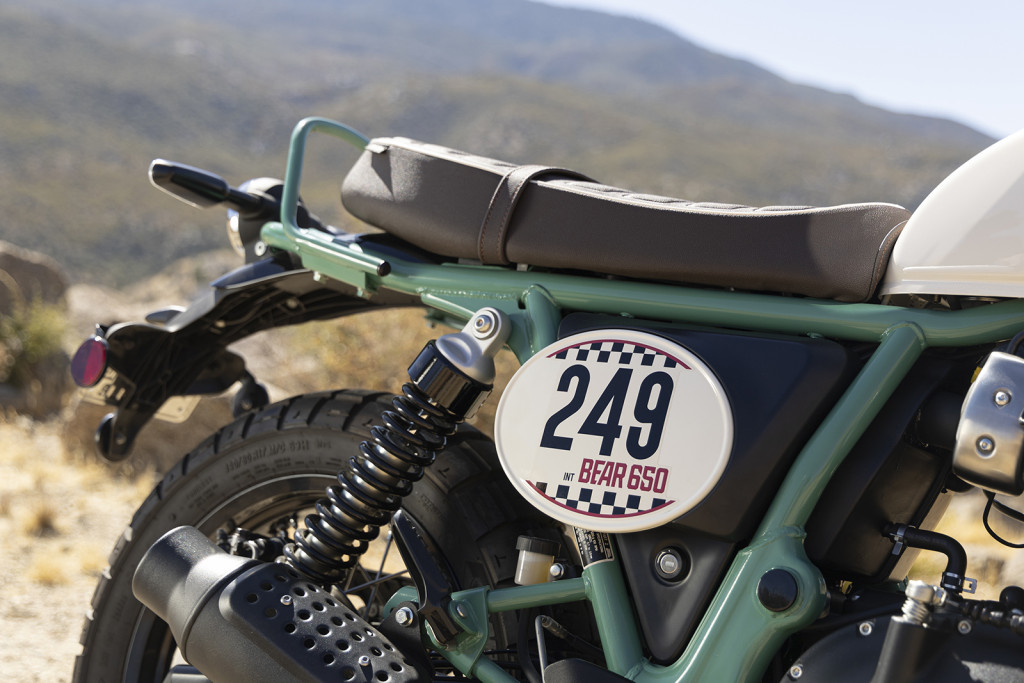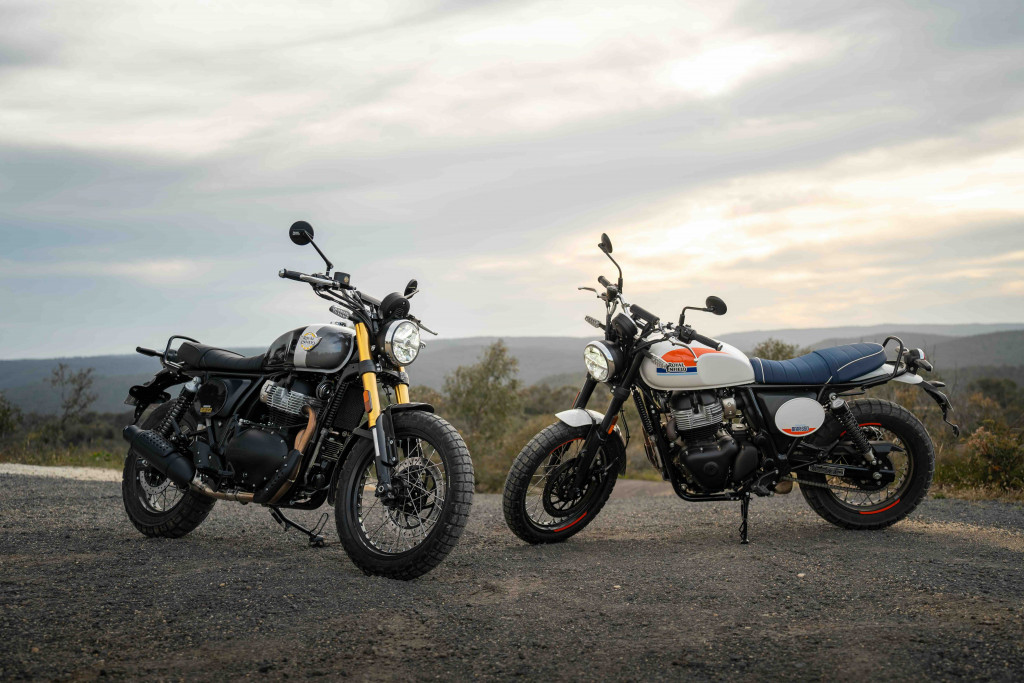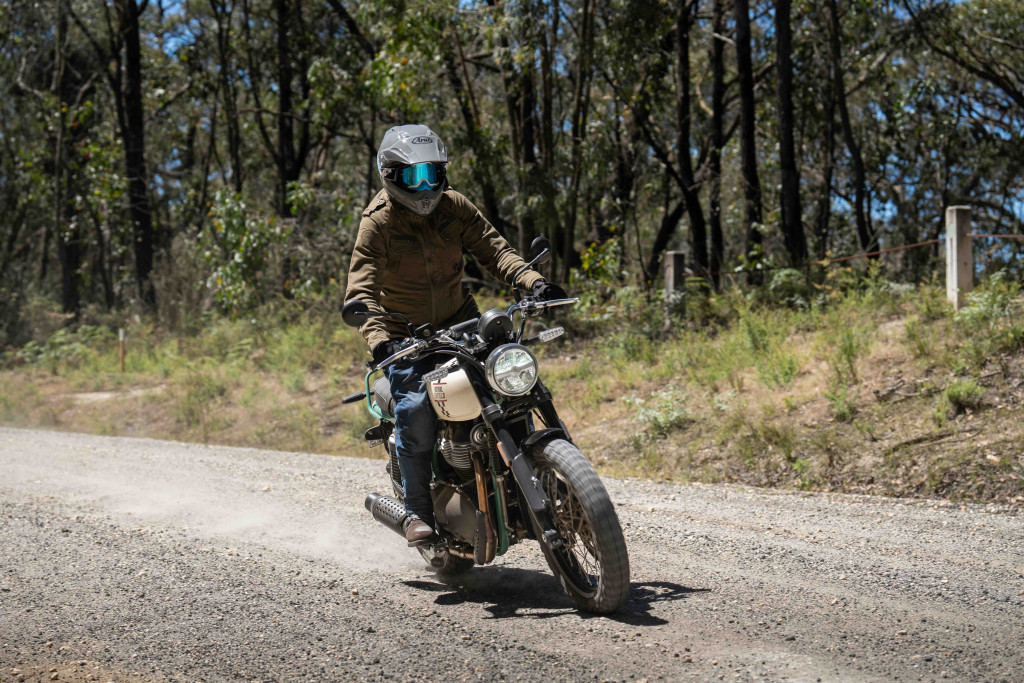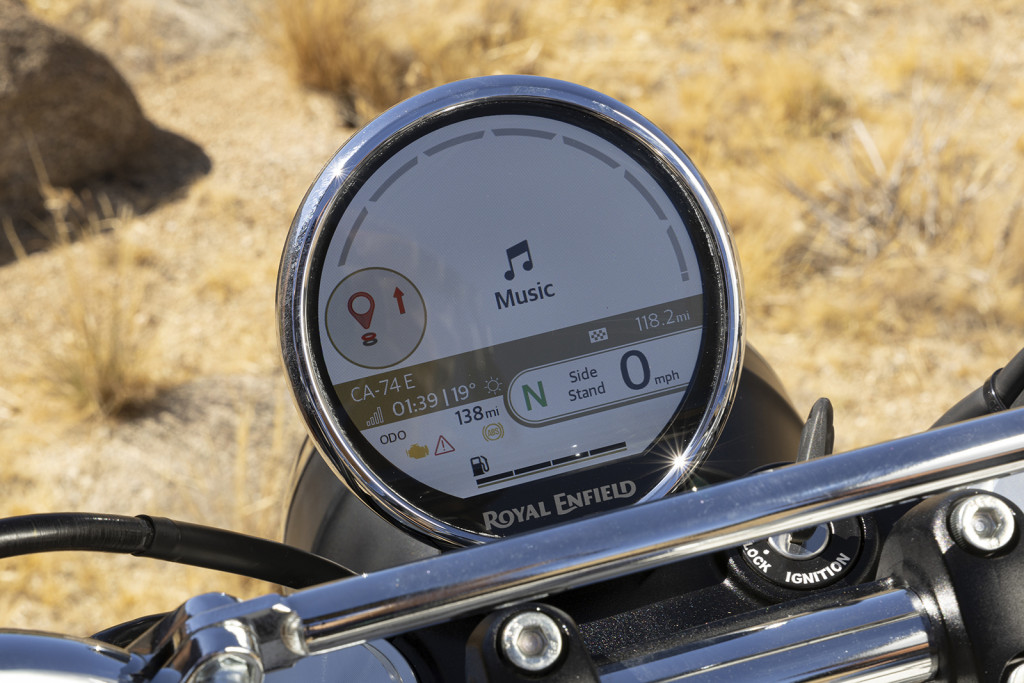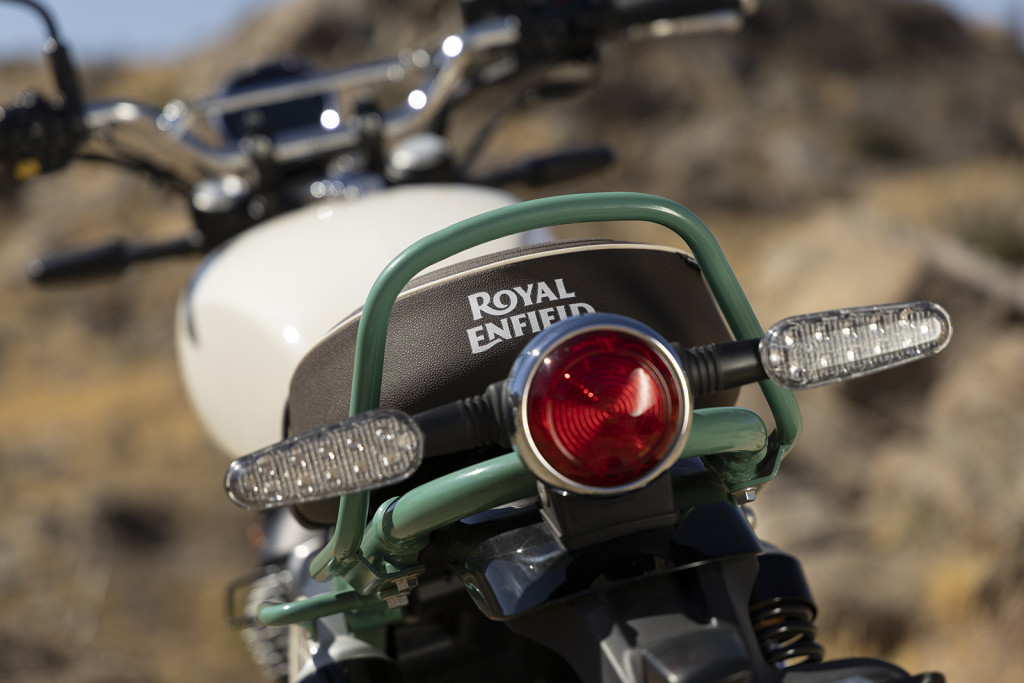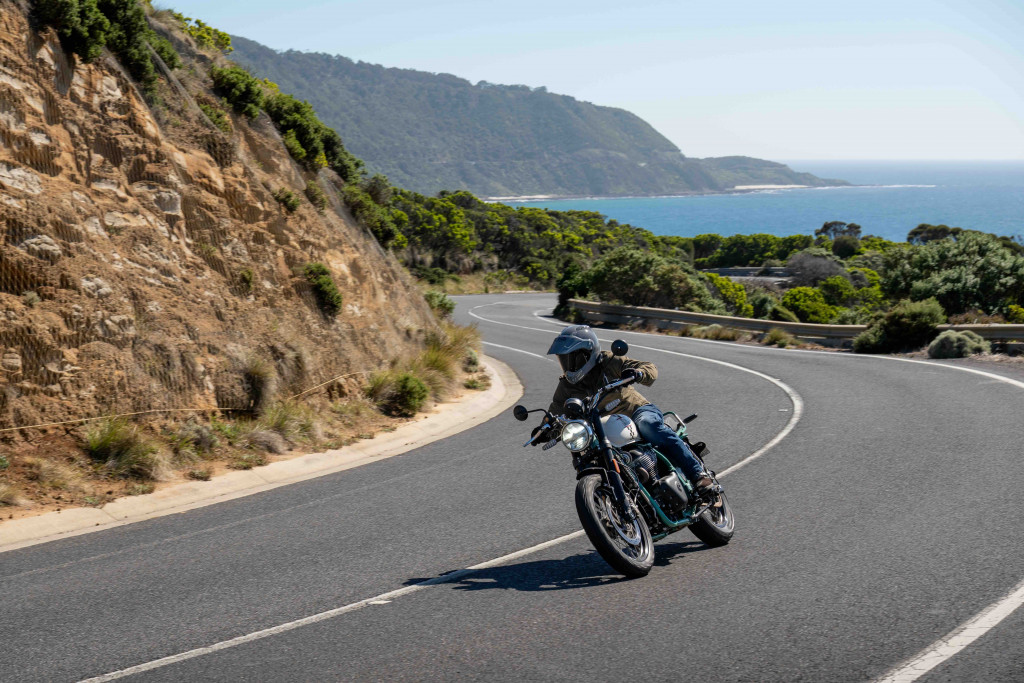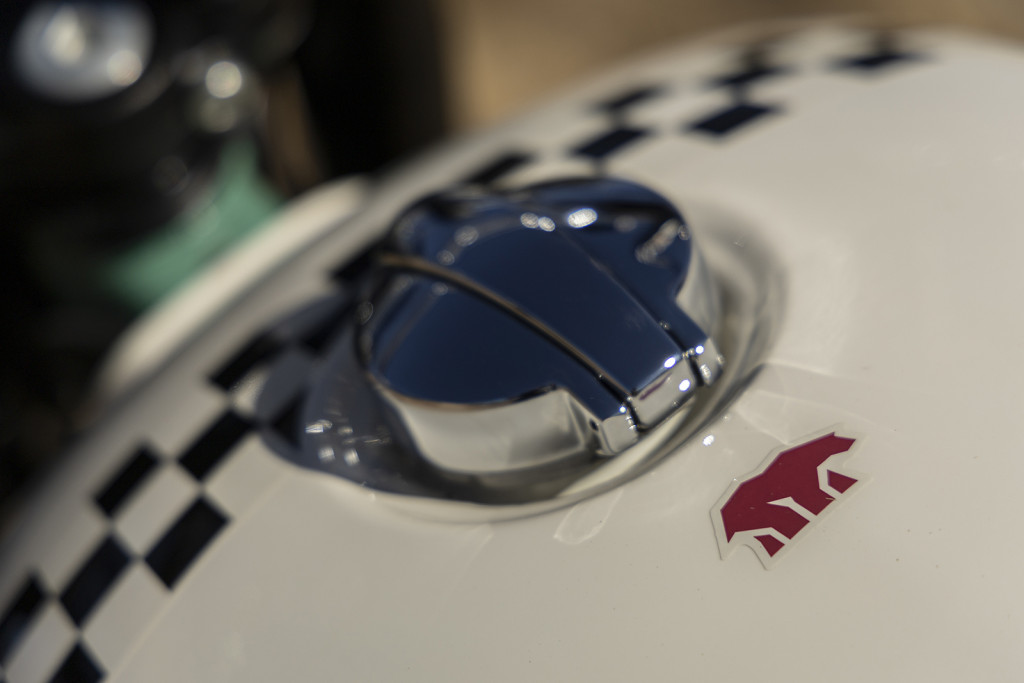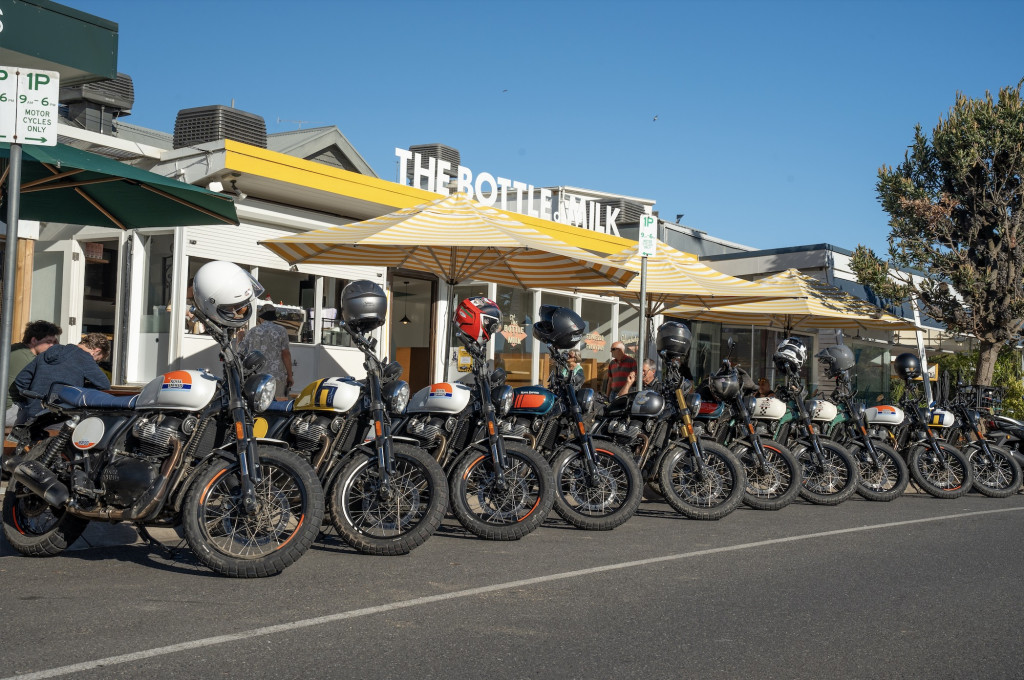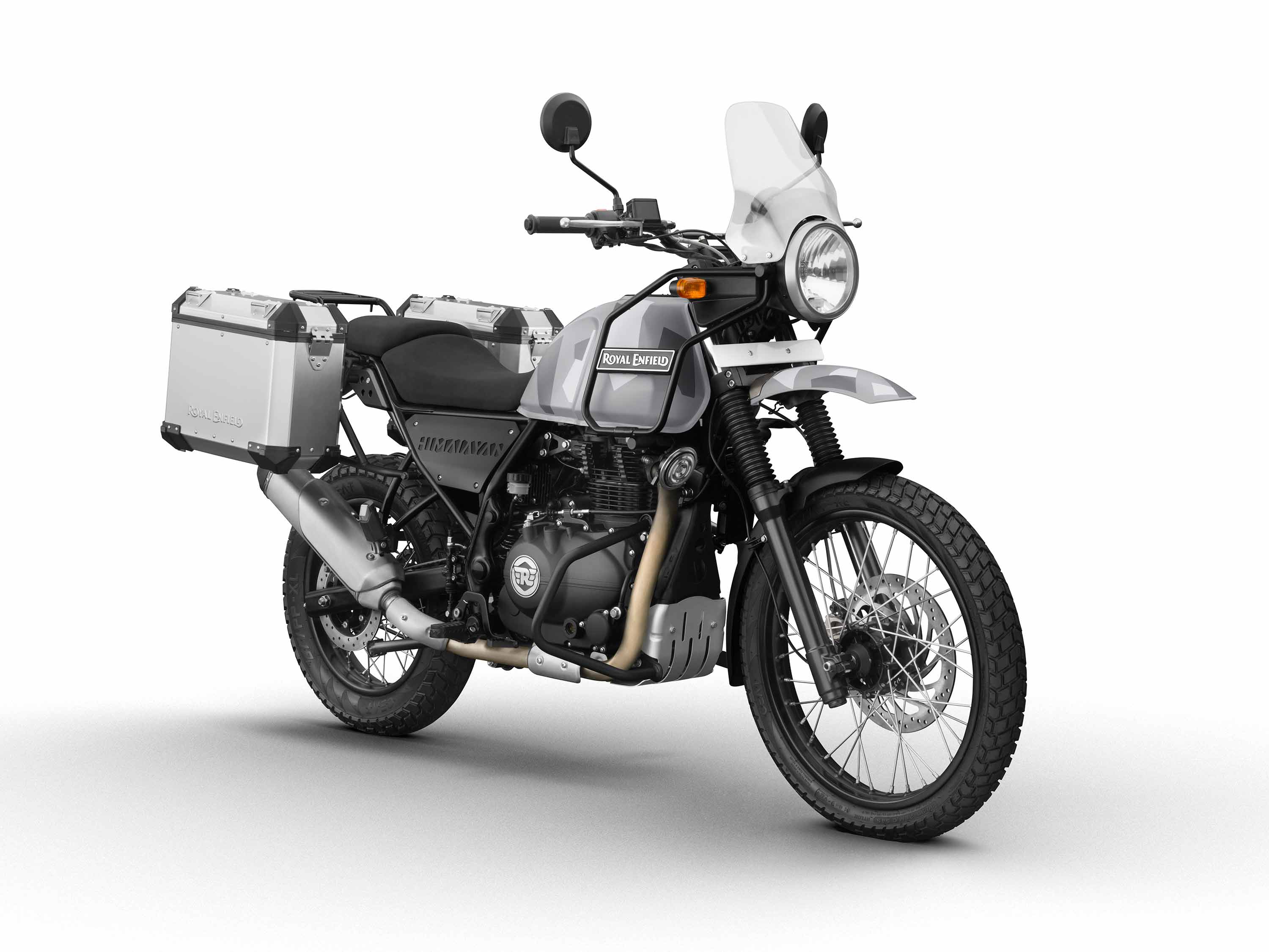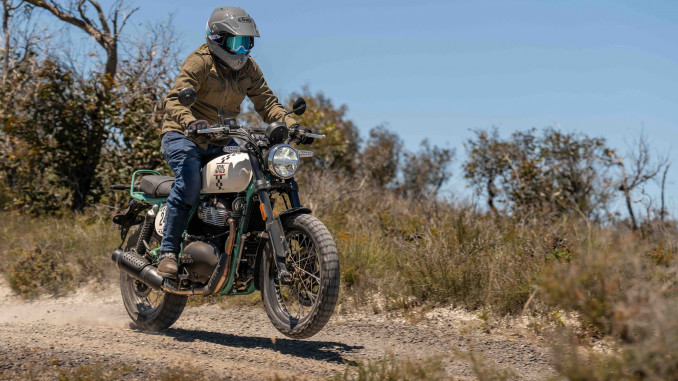
How does the Royal Enfield Bear 650 handle Aussie potholes and corrugations? Let’s find out…
PHOTOS TOM FOSSATI & MATTHEW HAYMAN
Before ARR Editor Deano splurged out on his own Royal Enfield Bear 650 he went on the Aussie launch of this retro scrambler to see how the bike would perform on Australia’s somewhat crappy roads, of both the blacktop and the dirt variety.
The local launch ride offered a detailed experience of what the Royal Enfield Bear 650 would be like to live with in a variety of conditions and scenarios, including around town, on busy freeways, on crook backroads, on corrugated and potholed gravel roads, as well as on some of the most sublime and picturesque twisties in the country.
The launch was a two-day affair out of Melbourne, through the Otways and down to the Great Ocean Road and back (see sidebar THE ROUTE). It provided plenty of opportunity to see what the Bear would be like to live with as a daily commuter, a weekend scratcher and even a dirt-road scrambler.
Let’s take a step back and recap exactly what the Bear 650 is, which is essentially what a whole bunch of bike customisers had already been doing with their Royal Enfield Interceptors; throwing on chunky rubber, lifting the guards, fitting a wide handlebar and doing their best Steve McQueen in On Any Sunday impersonation.
As well as the glaringly obvious styling differences between the Interceptor and the Bear, there are less obvious ones… as well as some completely out of sight ones. For starters, the Bear’s new two-into-one exhaust system is claimed to result in a bit more peak torque (+4Nm) with a claimed 56.5Nm available at 5150rpm, although peak power remains the same at 34.9kW at 7150rpm.
Other than where it kicks up at the back, the Bear 650’s frame looks very similar to the Interceptor’s, but it has been strengthened in key areas for light-duty off-road use. And the suspension has been upgraded significantly; gone is the conventional telescopic fork used on the Interceptor, replaced by a 43mm USD Showa Big Piston fork. The twin rear shocks are also now Showa items, and suspension travel has been increased both front and rear to 130mm and 115mm (+20mm and +27mm) respectively.
The Interceptor’s 18-inch wheels have been flicked in favour of a 19-inch/17-inch wheel combination, running chunky MRF Nylorex tyres (a 100/90-19 up front and a 140/80R17 at the rear) that were developed specifically for the Bear 650. At this stage there is no tubeless option for the Bear 650 tyres due to the spoked wheels used.
With the revised suspension and larger diameter front wheel, seat height is up to 830mm on the Bear 650 (+26mm) and ground clearance is up to 184mm (+10mm).
Other variations between the two bikes come down to styling, paint finishes, the seat, the use of LED lighting all around on the Bear 650, as well as the addition of a single TFT Tripper dash instead of the Interceptor’s twin analogue gauges.
Oh, there’s a price difference too, with the Interceptor available from $10,990 ride away and the Bear 650 priced from $11,490 ride away.
FIRST IMPRESSIONS
If you like a retro look you’re going to love the Bear 650. There’s no doubt Royal Enfield has nailed the styling of this bike. It’s purely subjective, but my favourite colourways are the Boardwalk White and Two Four Nine, which is the one tested here with the green frame, and which adds $400 to the ride away price. It is a tribute to Eddie Mulder who won a race in the California desert called the Big Bear Run in the 1960s on a Royal Enfield.
The first thing you notice when you throw your leg over the Bear is that it’s taller than the Interceptor 650 on which it’s based. Sure, it’s not an excessively high when compared to many adventure bikes, but it’s getting up there for shorties like me. Fortunately the seat is quite narrow where it meets the tank so it’s not too hard to plant both boots on the ground. The other thing that’s immediately noticeable is just how wide the handlebar is – yep, this is a bike that definitely has gravel riding in its remit.
The rider triangle feels quite generous and the seat is flat along its length so it’s easy to move around on the Bear 650. Both the clutch and brake levers offer span adjustment, the footpegs (which are slightly lower and further forward than those on the Interceptor) have removable rubber inserts, there’s a big hoop section behind the seat that’s well suited to tying luggage to, and there’s plenty of scope for adjustment if you want to roll the handlebar back for a shorter reach. If you do adjust the handlebar position, bear in mind (pun intended) that you’ll need to adjust the mirror stalks too, and that when looking in the otherwise comprehensive toolkit (behind the right-side number plate) I couldn’t find the correct-size spanner for the mirror-mount bolts. No biggie, but owners might want to add a couple of their own tools to the kit.
ON THE ROAD
The 650cc parallel twin is a gem, with a broad spread of torque throughout the rev range and enough poke up top to keep most riders happy. With a 270° crank it develops a deep, bellowing soundtrack through the stubby muffler that makes you want to blip the throttle at every opportunity. There’s also a nice note on overrun that might tempt you to do silly things in tunnels.
As you’d hope of a LAMS-compliant bike, the Bear is easy to ride around town with a progressive clutch, predictable power delivery and an upright riding position that makes it easy to see what’s going on around you. The mirrors can be a bit vibey at certain revs but they are well position to offer a decent view to the rear.
Once out of town and on the open road, that upright stance and wide handlebar mean you really feel the wind-blast at highway speeds, but there’s more than enough grunt on tap to happily cruise along at well over the posted limit. The tacho indicates a relaxed 4200rpm at 100km/h in top gear, and despite this being well short of the 5150rpm torque peak, there’s still plenty of grunt on tap from these revs to overtake without the need for downshifting.
If you do want to work the six-speed gearbox for faster acceleration, you’ll find that it shifts up and down the ratios smoothly.
Get onto some potted back roads and the non-adjustable Showa USD fork can feel a bit firm, but it offers good control and the front-end doesn’t deflect over road-surface irregularities. I added a couple of notches of preload on the twin rear shocks to add a bit more weight to the front of the bike but any difference was negligible.
With a single 320mm disc up front gripped by a Bybre twin-piston floating caliper, and a single 270mm disc at the rear with a single-piston caliper, braking performance is fine around town or for cruising on the highway, with good feel at the lever, but if you’re riding with sporting intent, the brakes can start to feel a bit wanting. Having said that, the ABS calibration os well sorted and doesn’t intervene too early.
The tread pattern on the MRF Nylorex tyres looks suspiciously like that on the Pirelli Scorpion Rally STR, and that’s pretty much how these tyres feel. They offer a surprising amount of grip on sealed roads for a blocky-style dual-purpose tyre and don’t generate excessive noise on the blacktop.
With a 19-inch front wheel you might expect the steering to be on the lethargic side, but the Bear 650 tips into corners with enthusiasm. After pushing it along at a decent clip on some fantastic twisting roads, I came away mightily impressed by just how much fun it was to ride, and even when cranked right over I never once scraped the footpegs or lost confidence in the tyres.
ON THE DIRT
Those MRF Nylorex tyres work exceptionally well on gravel roads, too, offering decent grip and a predictable feel when sliding around at high speeds… even at highway pressures.
Normally I’d let some air out of the tyres for gravel-road riding, but with quite a few bikes in our convoy it was decided to leave the tyres alone in an effort to stay on schedule. As a result, the bike felt a bit harsh over corrugations, but considering the tyre situation the suspension did a great job soaking up bumps.
Once you get into rougher terrain, the relatively limited suspension travel (130mm and 115mm) and moderate ground clearance (184mm) soon let you know that the Bear 650 isn’t really designed for huge jumps or crawling over obstacles, but it is still more capable – and fun – in the dirt than you might think. But remember, this is no lightweight dirtbike, and if you have to perform slow speed manoeuvres on rough and slippery surfaces, such as turning around on an off-camber track with a high crown, you’ll soon feel all of its 214kg.
The stand-up riding position is pretty good without too much of a stretch down to the handlebar, and you can dig your knees into the flat section on each side of the fuel tank to grip the bike; the riding position feels a bit like a late-70s trailbike when you’re up on the ’pegs. And if conditions turn damp and muddy, you can easily remove the rubber inserts from the footpegs, which have good teeth for your boots to get a grip on.
The ABS calibration is well suited to dirt-road riding too, allowing decent braking performance before intervening. And for those who want to slide the rear-end around in the dirt, the ABS is switchable, so you can lock up the rear into corners.
PRACTICALITIES
The Bear 650 scores Royal Enfield’s Tripper TFT dash that offers a bright and easy to read display with large speedo, tacho, fuel gauge and gear position indicator, and once hooked up to a phone using the Royal Enfield app, the screen can display messages, navigation and music selection, all operated via a toggle switch on the left switchblock. There are two display modes on the Tripper dash – analogue and digital – and while both offer full functionality, the analogue is the pick for day-to-day riding while the digital is the pick for navigation, as it shows a clear map screen on the dash.
After a full day in the saddle you might wish the seat offered a bit more width, but as mentioned, it’s easy to move around on to adjust your riding position, and it’s wider further back, so if you’re not carrying a pillion you can stretch out. Speaking of pillions, they are well catered for with decent seat cushioning and excellent grab handles, and they’re not perched up high above the rider.
There’s a USB-C port on the dash to keep your phone charged and the fuel tank holds 13.7 litres of go-juice. On the launch ride, the Bear 650 sipped down fuel at a rate of 4.0L/100km, so you can expect a touring range of more than 300km. (Over the past 1000km, Deano’s own Bear 650 has averaged 4.1L/100km).
VERDICT
The Royal Enfield Bear 650 exceeded my expectations… both on the road and in the dirt, and I have no doubt it’s going to be a sales hit for Royal Enfield, both here in Australia as well as in many other markets around the world.
The Bear is the fifth bike built on Royal Enfield’s 650 platform, which also consists the Interceptor, Continental, Super Meteor and Shotgun, and with a sixth model on the way (Classic 650) I can’t help but thinking each of these bikes must be pilfering at least some sales from their siblings. But hey, who am I to tell Royal Enfield how to do things? The Indian manufacturer sold 944,000 motorcycles last year, making it the 10th biggest motorcycle manufacturer in the world, and it expects to sell more than a million bikes in 2025!
As I mentioned in my original test, if I were to buy just one of them, the Bear 650 would probably be the one… and so it was.
THE TEST ROUTE
Our two-day ride started at Royal Enfield’s Aussie HQ in Pascoe Vale, just a few clicks north of Melbourne’s CBD. Once we escaped the urban crawl, we then headed southwest for a decent freeway stint before peeling off and dropping into the the Great Ocean Road Chocolaterie and Ice Creamery in Bellbrae for a late morning tea. Yep, life’s tough…
From here would head into the Great Otway National Park to sample the Bear 650 on some fast gravel roads and some slow dirt tracks before getting back on the bitumen and then dropping down into Lorne for a late lunch. We then headed a few west to our overnight stay at Cumberland River Holiday Park.
The following morning, after getting up early to grab a few pre-sunrise shots along the Great Ocean Road, we doubled back to Lorne for brekky, fuelled up and then headed west again towards Skenes Creek. For those who have not ridden along the Great Ocean Road before, all I can say is “Do it!”, and this 40km section in particular is one of the greatest rides of them all, especially on a weekday and out of holiday season. The road is fantastic, with so many twists and turns and undulations you’ll start to wonder where all the straights have gone, and for the most part, the road surface is pretty decent too. Oh, and then there’s the scenery, with the blue waters of Bass Strait to one side and spectacular green forest to the other.
After a comfort stop at Skenes Creek, we headed up the hill towards Forrest for, you guessed it, morning tea – sure, we’d only covered around 65km since breakfast, but this was thirsty work. The ride from the coast and up into the hills is another ripper, with plenty of twists and turns, but it pays to keep an eye on the road surface here with occasional bits of potted bitumen, a few sections of road works and some unexpected bumps. Perfect for testing motorcycles then…
From Forrest it’s around 170km back to Pascoe Vale, so a lunch stop en route would obviously be required, so we stopped off at Mount Duneed Estate to fuel up our bodies before the last 100km freeway run back to Royal Enfield’s HQ. By the time we peeled off the M80 and on to the M79, there was heavy afternoon traffic to negotiate on a day in which the mercury was nudging 35°C, so we were all pretty thirsty by the time we dismounted.
THE COMPETITION
Triumph Scrambler 400 X
$9990 ride away
Although it gives away one cylinder and 250cc to the Bear 650, the Triumph Scrambler 400 X is clearly gunning for the same buyer who wants a retro-styled LAMS-compliant scrambler. The Scrambler 400 X’s liquid-cooled single makes a claimed 29.4kW at 8000rpm and 37.5Nm at 6500rpm. It is much lighter than the Bear at 179kg (wet), but it has a slightly higher 835mm seat height (+5mm). Like the Bear, the Scrambler 400 X runs 19-inch front and 17-inch rear wheels with 100/90-19 and 140/80-17 tyres. At $9990 ride away, the Scrambler 400 X undercuts the Bear 650 by $1500.
Honda CL500
$8999 plus on-road costs
Honda’s LAMS-compliant scrambler is called the CL500 and it’s powered by a liquid-cooled 471cc parallel twin that makes a claimed 34.3kW at 8500rpm and 43.4Nm at 6250rpm. Unlike the Bear 650 or the Triumph Scrambler 400 X, which both run a 270° crank, the CL500 runs a 180° crank and as a result the engine lacks that V-twin-like character of its competition. Nevertheless, it offers reasonable performance combined with that scrambler look, the latter courtesy of the 19/17-inch wheel combo, blocky tyres, high exhaust and old-school for gaiters.
Benelli Leoncino 500 Trail
$10,390 ride away
The LAMS-compliant Benelli Leoncino 500 Trail runs a liquid-cooled 499.6cc parallel twin that makes a claimed 35kW at 8500rpm and 45Nm at 5000rpm. With a two-into-one exhaust, cut guards, wide handlebar, 19/17-inch wheel combo and chunky Pirelli Scorpion Rally STR tyres, it nails the scrambler look, even if it doesn’t quite give off the retro vibe of the Bear 650. It tips the scales at 170kg dry.
Husqvarna Svartpilen 401
$8795 ride away
The Svartpilen 401 is a radical-looking machine but thanks to its short mudguard, off-road-style handlebar and chunky Pirelli Scorpion Rally STR rubber, it kind of exudes a scrambler look, even if it’s really more of an urban roadster with its 17-inch wheels front and rear. It’s powered by a liquid-cooled 398.6cc single that makes a claimed 33.5kW at 8500rpm and 39Nm at 7000rpm, and it tips the scales at a lithe 159kg (wet/no fuel). If you want a LAMS-compliant bike with chunky rubber that offers impeccable on-road manners, the Svartpilen is definitely worth a look.
CFMoto 700 CL-X Adventure
$10,990 ride away
Okay, so the 700 CL-X Adventure isn’t LAMS-compliant, but in some ways (think engine capacity and price) it is the closest competitor to the Bear 650. The CL-X is powered by a liquid-cooled 693cc parallel twin that makes a claimed 55kW at 8500rpm and 68Nm at 6500rpm. It runs an 18/17-inch wheel combination with Pirelli Scorpion Rally STR tyres, and it tips the scales at 204kg wet. If you have your full licence and you want a full-power budget-priced scrambler, the 700 CL-X Adventure is well worth a look.
COLOURWAYS
There are five colour options in the Bear 650 line up, with the no-cost option being Boardwalk White.
Spend an extra $200 and you can have your Bear in Golden Shadow (with trick-looking gold fork legs), Petrol Green or Wild Honey.
Want to pay tribute to Eddie Mulder’s Big Bear Run race win? The green-framed Two Four Nine colourway adds $400 to the price tag.
Specifications – Royal Enfield Bear 650
ENGINE
Type: Air/oil-cooled parallel twin, SOHC, four valves per cylinder
Capacity: 648cc
Compression ratio: 9.5:1
Engine management: EFI
PERFORMANCE
Claimed maximum power: 34.9kW (47.4hp) @ 7150rpm
Claimed maximum torque: 56.5Nm @ 5150rpm
Fuel Consumption: 4.0L per 100km (measured)
TRANSMISSION
Type: Constant-mesh 6-speed gearbox
Final drive: Chain
Clutch: Wet, multi-plate
CHASSIS AND RUNNING GEAR
Chassis: Tubular steel; double cradle
Front suspension: Showa 43mm USD fork, 130mm of travel
Rear suspension: Double-sided swing arm with twin shocks, preload adjustable, 115mm travel,
Front brakes: Single 320mm disc, Bybre twin-piston caliper
Rear brake: Single 270mm disc, single-piston caliper
Tyres: MRF Nylorex F: 100/90-19 (57H) R: 140/80BR17 (69H)
DIMENSIONS AND CAPACITIES
Rake: Not given
Trail: Not given
Claimed kerb weight: 214kg
Seat height: 835mm
Wheelbase: 1460mm
Fuel capacity: 13.7L
ELECTRONICS, RIDER AIDS & CONVENIENCE FEATURES
Switchable two-channel ABS; TFT Tripper dash with Bluetooth connectivity for navigation, messages and music
ETCETERA
Price: From $11,490 ride away
Colours: Boardwalk White; Golden Shadow, Petrol Green or Wild Honey ($200); Two For Nine ($400)
Testbike supplied by: Urban Moto Imports
Service intervals: 12000km/12 months
Warranty: 3 years, unlimited km
Website: https://royalenfield.com.au/model/bear-650/

